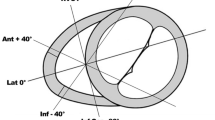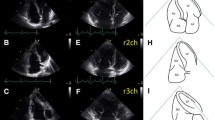Abstract
Real-time three-dimensional (3D) echocardiography allows us to measure right ventricular (RV) end-diastolic volume irrespective of its shape. Tissue Doppler imaging (TDI) and speckle tracking imaging (STI) are new tools to assess myocardial function. We sought to evaluate RV function by 3D echocardiography and myocardial strain imaging in adult patients with atrial septal defect (ASD) before and 6 months after transcatheter closure in order to assess the utility of these new indexes in comparison with standard two-dimensional (2D) and Doppler parameters. Thirty-nine ASD patients and 39 healthy age- and sex-matched controls were studied using a commercially available cardiovascular ultrasound system. 2D-Doppler parameters of RV function (fractional area change, tricuspid annular plane systolic excursion, myocardial performance index) were calculated. 3D RV volumes were also obtained. RV peak-systolic velocities, peak-systolic strain, and peak systolic and diastolic strain-rate were measured in the basal, mid and apical segments of lateral and septal walls in apical 4-chamber view by TDI and STI. In open ASD, RV ejection fraction (3D-RVEF) and global and regional RV longitudinal strain were significantly higher than control group and decreased significantly after closure. By multivariate analysis 3D-RVEF, apical strain and strain rate were independent predictors of functional class. ROC analysis showed 3D-RVEF and apical strain to be more sensitive predictors of unfavorable outcome after defect closure compared to 2D-Doppler indexes. 3D echocardiography and myocardial strain imaging give useful insights in the quantitative assessment of RV function in ASD patients before and after closure.



Similar content being viewed by others
References
Sheehan F, Redington A (2008) The right ventricle: anatomy, physiology and clinical imaging. Heart 94:1510–1515
Gopal AS, Chukwu EO, Iwuchukwu CJ, Katz AS, Toole RS, Schapiro W, Reichek N (2007) Normal values of right ventricular size and function by real-time 3-dimensional echocardiography: comparison with cardiac magnetic resonance imaging. J Am Soc Echocardiogr 20:445–455
van der Zwaan HB, Helbing WA, McGhie JS, Geleijnse ML, Luijnenburg SE, Roos-Hesselink JW, Meijboom FJ (2010) Clinical value of real-time three-dimensional echocardiography for right ventricular quantification in congenital heart disease: validation with cardiac magnetic resonance imaging. J Am Soc Echocardiogr 23:134–140
Sade LE, Gülmez O, Ozyer U, Ozgül E, Ağildere M, Müderrisoğlu H (2009) Tissue Doppler study of the right ventricle with a multisegmental approach: comparison with cardiac magnetic resonance imaging. J Am Soc Echocardiogr 22:361–368
Pirat B, McCulloch ML, Zoghbi WA (2006) Evaluation of global and regional right ventricular systolic function in patients with pulmonary hypertension using a novel speckle tracking method. Am J Cardiol 98:699–704
Teske AJ, De Boeck BWL, Olimulder M, Prakken NH, Doevendans PAF, Cramer MJ (2008) Echocardiographic assessment of regional right ventricular function: a head-to-head comparison between 2-dimensional and tissue Doppler–derived strain analysis. J Am Soc Echocardiogr 21:275–283
Lang RM, Bierig M, Devereux RB, Flachskampf FA, Foster E, Pellikka PA, Picard MH, Roman MJ, Seward J, Shanewise J, Solomon S, Spencer KT, St John Sutton M, Stewart W (2005) Recommendations for chamber quantification: a report from the American Society of Echocardiography’s Guidelines and Standards Committee and the Chamber Quantification Writing Group, developed in conjunction with the European Association of Echocardiography, a branch of the European Society of Cardiology. J Am Soc Echocardiogr 18:1440–1463
Dittman H, Jackson R, Voelker W, Karsch KR, Seipel L (1988) Accuracy of Doppler echocardiography in quantitation of left to right shunts in adult patients with atrial septal defect. J Am Coll Cardiol 11:338–342
Kaul S, Tei C, Hopkins JM, Shah PM (1984) Assessment of right ventricular function using two dimensional echocardiography. Am Heart J 128:301–307
Yeo TC, Dujardin KS, Tei C, Mahoney DW, McGoon MD, Seward JB (1998) Value of a Doppler-derived index combining systolic and diastolic time intervals in predicting outcome in primary pulmonary hypertension. Am J Cardiol 81:1157–1161
Berger M, Haimowitz A, Van Tosh A, Berdoff RL, Goldberg E (1985) Quantitative assessment of pulmonary hypertension in patients with tricuspid regurgitation using continuous wave Doppler ultrasound. J Am Coll Cardiol 6:359–365
Yong G, Khairy P, De Guise P, Dore A, Marcotte F, Mercier LA, Noble S, Ibrahim R (2009) Pulmonary arterial hypertension in patients with transcatheter closure of secundum atrial septal defects: a longitudinal study. Circ Cardiovasc Interv 2:455–462
Rudski LG, Lai WW, Afilalo J, Hua L, Handschumacher MD, Chandrasekaran K, Solomon SD, Louie EK, Schiller NB (2010) Guidelines for the echocardiographic assessment of the right heart in adults: a report from the American Society of Echocardiography endorsed by the European Association of Echocardiography, a registered branch of the European Society of Cardiology, and the Canadian Society of Echocardiography. J Am Soc Echocardiogr 23:685–713
Metz CE (1986) Receiver operating characteristic methodology in radiologic imaging. Invest Radiol 21:720–733
Veldtman GR, Razack V, Siu S, El-Hajj H, Walker F, Webb GD, Benson LN, McLaughlin PR (2001) Right ventricular form and function after percutaneus atrial septal defect device closure. J Am Coll Card 37:2108–2113
Ding J, Ma G, Huang Y, Wang C, Zhang X, Zhu J, Lu F (2009) Right ventricular remodeling after transcatheter closure of atrial septal defect. Echocardiography 26:1146–1152
Du Z, Cao Q, Koening P, Heitschmidt M, Hijazi Z (2001) Speed of normalization of right ventricular volume overload after transcatheter closure of atrial septal defect in children and adults. Am J Cardiol 88:1450–1453
Ding J, Ma G, Wang C, Huang Y, Zhang X, Zhu J, Lu F (2009) Acute effect of transcatheter closure on right ventricular function in patients with atrial septal defect assessed by tissue Doppler imaging. Acta Cardiol 64:303–309
Kaya MG, Baykan A, Dogan A, Inanc T, Gunebakmaz O, Dogdu O, Uzum K, Eryol NK, Narin N (2010) Intermediate-term effects of transcatheter secundum atrial septal defect closure on cardiac remodeling in children and adults. Pediatr Cardiol 31:474–482
Shaheen J, Alper L, Rosenmann D, Klutstein MW, Falkowsky G, Bitran D, Tzivoni D (2000) Effect of surgical repair of secundum-type atrial septal defect on right atrial, right ventricular, and left ventricular volumes in adults. Am J Cardiol 86:1395–1397
Dhillon R, Josen M, Henein M, Redington A (2002) Transcatheter closure of atrial septal defect preserves right ventricular function. Heart 87:461–465
Teo KS, Dundon BK, Molaee P, Williams KF, Carbone A, Brown MA, Worthley MI, Disney PJ, Sanders P, Worthley SG (2008) Percutaneous closure of atrial septal defects leads to normalisation of atrial and ventricular volumes. J Cardiovasc Magn Reson 10:55–63
Schussler JM, Anwar A, Phillips SD, Roberts BJ, Vallabhan RC, Grayburn PA (2005) Effect on right ventricular volume of percutaneous Amplatzer closure of atrial septal defect in adults. Am J Cardiol 95:993–995
Kret M, Arora R (2007) Pathophysiological basis of right ventricular remodeling. J Cardiovasc Pharmacol Ther 12:5–14
Pascotto M, Caso P, Santoro G, Caso I, Cerrato F, Pisacane C, D’Andrea A, Severino S, Russo MG, Calabrò R (2004) Analysis of right ventricular Doppler tissue imaging and load dependence in patients undergoing percutaneous closure of atrial septal defect. Am J Cardiol 94:1202–1205
Weidemann F, Jamal F, Sutherland GR, Claus P, Kowalski M, Hatle L, De Scheerder I, Bijnens B, Rademakers FE (2002) Myocardial function defined by strain rate and strain during alterations in inotropic states and heart rate. Am J Physiol Heart Circ Physiol 283:H792–H799
Jamal F, Bergerot C, Argaud L, Loufouat J, Ovize M (2003) Longitudinal strain quantitates regional right ventricular contractile function. Am J Physiol Heart Circ Physiol 285:H2842–H2847
Missant C, Rex S, Claus P, Mertens L, Wouters PF (2008) Load-sensitivity of regional tissue deformation in the right ventricle: isovolumic versus ejection-phase indices of contractility. Heart 94:e15–e21
La Gerche A, Jurcut R, Voigt JU (2010) Right ventricular function by strain echocardiography. Curr Opin Cardiol 25:430–436
Vitarelli A, Terzano C (2010) Do we have two hearts? New insights in right ventricular function supported by myocardial imaging echocardiography. Heart Fail Rev 15:39–61
Van De Bruaene A, Buys R, Vanhees L, Delcroix M, Voigt JU, Budts W (2011) Regional right ventricular deformation in patients with open and closed atrial septal defect. Eur J Echocardiogr 12:206–213
Jategaonkar SR, Scholtz W, Butz T, Bogunovic N, Faber L, Horstkotte D (2009) Two-dimensional strain and strain rate imaging of the right ventricle in adult patients before and after percutaneous closure of atrial septal defects. Eur J Echocardiogr 10:499–502
Eyskens B, Ganame J, Claus P, Boshoff D, Gewillig M, Mertens L (2006) Ultrasonic strain rate and strain imaging of the right ventricle in children before and after percutaneous closure of an atrial septal defect. J Am Soc Echocardiogr 19:994–1000
Korinek J, Wang J, Sengupta PP, Miyazaki C, Kjaergaard J, McMahon E, Abraham TP, Belohlavek M (2005) Two-dimensional strain—a Doppler independent ultrasound method for quantitation of regional deformation: validation in vitro and in vivo. J Am Soc Echocardiogr 18:1247–1253
Dong L, Zhang F, Shu X, Zhou D, Guan L, Pan C, Chen H (2009) Left ventricular torsional deformation in patients undergoing transcatheter closure of secundum atrial septal defect. Int J Cardiovasc Imaging 25:479–486
Amundsen BH, Helle-Valle T, Edvardsen T, Torp H, Crosby J, Lyseggen E, Støylen A, Ihlen H, Lima JA, Smiseth OA, Slørdahl SA (2006) Noninvasive myocardial strain measurement by speckle tracking echocardiography: validation against sonomicrometry and tagged magnetic resonance imaging. J Am Coll Cardiol 47:789–793
Hsiao SH, Wang WC, Yang SH, Lee CY, Chang SM, Lin SK, Chiou KR (2008) Myocardial tissue Doppler-based indexes to distinguish right ventricular volume overload from right ventricular pressure overload. Am J Cardiol 101:536–541
Szabó G, Soós P, Bährle S, Radovits T, Weigang E, Kékesi V, Merkely B, Hagl S (2006) Adaptation of the right ventricle to an increased afterload in the chronically volume overloaded heart. Ann Thorac Surg 82:989–995
Yerebakan C, Klopsch C, Niefeldt S, Zeisig V, Vollmar B, Liebold A, Sandica E, Steinhoff G (2010) Acute and chronic response of the right ventricle to surgically induced pressure and volume overload–an analysis of pressure-volume relations. Interact Cardiovasc Thorac Surg 10:519–525
Morikawa T, Murata M, Okuda S, Tsuruta H, Iwanaga S, Murata M, Satoh T, Ogawa S, Fukuda K (2011) Quantitative analysis of right ventricular function in patients with pulmonary hypertension using three-dimensional echocardiography and a two-dimensional summation method compared to magnetic resonance imaging. Am J Cardiol 107:484–489
Balint OH, Samman A, Haberer K, Tobe L, McLaughlin P, Siu SC, Horlick E, Granton J, Silversides CK (2008) Outcomes in patients with pulmonary hypertension undergoing percutaneous atrial septal defect closure. Heart 94:1189–1193
Kefer J, Sluysmans T, Hermans C, El Khoury R, Lambert C, Van de Wyngaert F, Ovaert C, Pasquet A (2012) Percutaneous transcatheter closure of interatrial septal defect in adults: procedural outcome and long-term results. Cathet Cardiovasc Interv 79:322–330
Hedman A, Alam M, Zuber E, Nordlander R, Samad BA (2004) Decreased right ventricular function after coronary artery bypass grafting and its relation to exercise capacity: a tricuspid annular motion-based study. J Am Soc Echocardiogr 17:126–131
Giusca S, Dambrauskaite V, Scheurwegs C, D’hooge J, Claus P, Herbots L, Magro M, Rademakers F, Meyns B, Delcroix M, Voigt JU (2010) Deformation imaging describes right ventricular function better than longitudinal displacement of the tricuspid ring. Heart 96:281–288
van der Hulst AE, Delgado V, Holman ER, Kroft LJ, de Roos A, Hazekamp MG, Blom NA, Bax JJ, Roest AA (2010) Relation of left ventricular twist and global strain with right ventricular dysfunction in patients after operative “correction” of tetralogy of Fallot. Am J Cardiol 106:723–729
Acknowledgments
We thank Bruno Montella of Eidomedica for helpful support and technical assistance.
Conflict of interest
None.
Author information
Authors and Affiliations
Corresponding author
Rights and permissions
About this article
Cite this article
Vitarelli, A., Sardella, G., Roma, A.D. et al. Assessment of right ventricular function by three-dimensional echocardiography and myocardial strain imaging in adult atrial septal defect before and after percutaneous closure. Int J Cardiovasc Imaging 28, 1905–1916 (2012). https://doi.org/10.1007/s10554-012-0022-8
Received:
Accepted:
Published:
Issue Date:
DOI: https://doi.org/10.1007/s10554-012-0022-8




